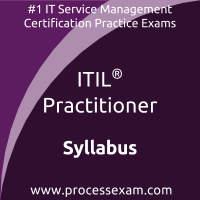
To achieve the professional designation of ITIL Practitioner, candidates must clear the ITIL Practitioner Exam with the minimum cut-off score. For those who wish to pass the ITIL Practitioner certification exam with good percentage, please take a look at the following reference document detailing what should be included in ITIL Practitioner Exam preparation.
The ITIL Practitioner Exam Summary, Body of Knowledge (BOK) and Sample Question Bank, provide the basis for the real ITIL Practitioner exam. If you have made this decision to become a certified professional, it is advisable to take authorized training and prepare with an online ITIL Practitioner Practice Exam to achieve the best result. We have designed these resources to help you get ready to take ITIL Practitioner exam.
ITIL Practitioner Exam Summary:
| Exam Name | ITIL Practitioner |
| Exam Code | ITIL Practitioner |
| Exam Fee | USD $150 |
| Exam Duration | 135 Minutes |
| Number of Questions | 40 |
| Passing Score | 70% |
| Format | Multiple Choice |
| Sample Questions | ITIL Practitioner Exam Sample Questions and Answers |
| Practice Exam | ITIL Practitioner Practice Test |
ITIL Practitioner Syllabus Topics:
| Unit | Content |
| 1 |
- Apply the concept of ‘adopt and adapt’ when using ITIL guidance in a given context - Analyze the importance of each element of a service when planning and implementing service improvements |
| 2 | - Apply the ITSM guiding principles in a given context when planning and implementing service improvements |
| 3 |
- Describe the purpose and main outputs of each step of the CSI Approach - Use the CSI Approach tools and techniques successfully in a given specific context - Apply the CSI approach to a given context, demonstrating an understanding of the critical competences, the guiding principles and the scientific method |
| 4 |
- Define critical success factors (CSFs) using a relevant hierarchical approach - Determine key performance indicators (KPIs) to underpin a critical success factor - Analyze CSFs and KPIs in a given context to ensure that they are balanced between the four categories - Define a current state assessment in a given context - Design a report in a given context - Apply knowledge of metrics and measurement when planning and implementing improvements, particularly in the context of the CSI approach and/or the guiding principles |
| 5 |
- Explain the nature, value, importance and benefits of good communication - Explain communication principles - Explain the purpose and value of communication tools and techniques - Use relevant communication tools and techniques to support improvement in a given context - Apply knowledge of communications when planning and implementing improvements, particularly in the context of the CSI approach and/or the guiding principles |
| 6 |
- Explain the role and impact of OCM in successful improvement - Describe the purpose and value of OCM activities - Use relevant OCM tools and techniques to support improvement in a given context - Apply knowledge of OCM when planning and implementing improvements, particularly in the context of the CSI approach and/or the guiding principles |
